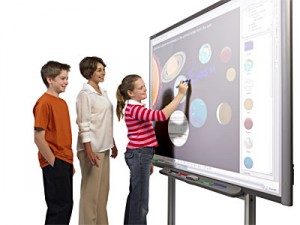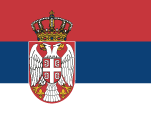The application of electronic interactive boards (which are also known as electronic whiteboards, smart boards or interactive multimedia boards) transforms traditional teaching into interactive teaching that meets the educational needs of modern students and leads to the achievement of the desired learning outcomes, which are in accordance with requirements of modern society.
This type of teaching ensures better student motivation and increases their attention span, thanks to the fact that students in this type of teaching can be more active and participate more, instead of concentrating on taking notes. The use of different sources of knowledge greatly enriches the content of classes and contributes to the development of students’ functional abilities.
To organize classes in this way, you need a computer, a projector and a projection surface on which presentations, writing, drawing, etc. are carried out. You can write on the blackboard with special pencils (also with your fingers on some models), and writing balls are also designed for the youngest age group. Interactive boards work by sending information from the board to the computer, the computer controls the image on the board, which is at the same time a canvas on which the image is constantly projected, but also generates feedback to the computer system.
As was stated at the international conference “Technology and Informatics in Education”, which was held in June of this year in Serbia, the use of interactive whiteboards in teaching enables greater student participation in the teaching process, a greater variety of content and methods in teaching, and therefore a greater possibility of adapting to different learning styles of students, easier understanding of more complicated tasks thanks to clearer, more dynamic and effective presentations, development of digital skills of students as well as teachers, greater creativity and, due to all of the above, greater motivation to learn.
 The use of interactive whiteboards in the creation of teaching materials allows the teacher to use documents from various programs on the desktop, mark, zoom the text, highlight the text using the “spotlight” option and use many other functionalities, which are used to focus on important content. It also allows the teacher to save all changes made during the lecture, or keep the presentation in its original form so that the next lecture could follow a different path, according to the needs of the students.
The use of interactive whiteboards in the creation of teaching materials allows the teacher to use documents from various programs on the desktop, mark, zoom the text, highlight the text using the “spotlight” option and use many other functionalities, which are used to focus on important content. It also allows the teacher to save all changes made during the lecture, or keep the presentation in its original form so that the next lecture could follow a different path, according to the needs of the students.
You can circle, write or draw different shapes (that can be easily recognized as regular geometric shapes) on interactive boards using pencils or your fingers, and with simple movements, you can arrange the given elements on the surface, i.e. board, which is especially useful for schematic representations.
Also, during the presentation, it is possible to connect to other pages on the desktop, to connect to other documents and programs on the computer, and to connect to Internet webpages. This option ensures the necessary dynamics in the teaching process and makes it simple to include numerous examples in the process of explaining the learning material, which is of great importance for the development of students’ practical knowledge and skills.
The introduction of interactive electronic boards in teaching at ITS makes lectures and the learning process more attractive, dynamic and meaningful. It enables teachers to be more creative in composing teaching materials, facilitates the process of saving, changing and forwarding materials to students, and helps students to be fully involved in the learning process.
Students no longer have to worry about taking notes or trying to stay focused, because this way, above all, their motivation for active participation in the learning process is encouraged.
